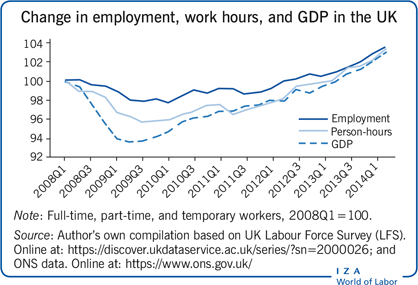Elevator pitch
The responses of working hours and employment levels to temporary negative demand shocks like those caused by the Great Recession in 2007–2008 and the Covid-19 pandemic in 2020–2022 have shown that consideration of both is important. Workers’ desired rises in working hours in times of recession also serve to modify the standard measure of unemployment. During Covid-19, both jobs and earnings were temporarily protected among workers forced into short-time work schemes, providing a useful comparison with the provision of improved unemployment insurance to unemployed workers at that time.

Key findings
Pros
Hours per worker drop sharply at the start of negative demand shocks in contrast to slower employment adjustment.
Peak-to-trough falls in UK and US hours during the Great Recession were mainly due to transitions from full-time to part-time employment under the same employer.
There are advantages in funding both job retention schemes and unemployment benefits during major recessions.
Cons
Unemployment rates underestimate the full impact of negative demand shocks since they fail to account for desired rises in working hours.
Job retention via short-time work schemes during recessions may reduce productive job reallocations.
Omitting capital and capacity utilization adjustments to demand shocks may distort the measurements of hours and employment effects.